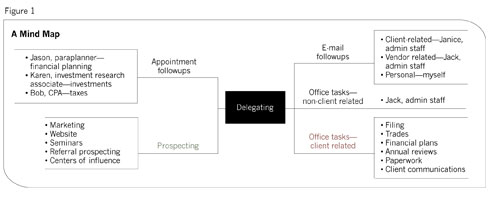Keeping track of everything that you do and say in a financial advisor's practice can be a daunting challenge, particularly in offices with staff and/or multiple advisors. With a mature firm, typically hundreds of things could be going on that require tracking, from follow-up tasks to managerial oversight of employees.
An efficient financial advisor's office should be one where nothing slips through the cracks. Follow-ups are done promptly, consistently and accurately. But the reality is that this is often a difficult goal to achieve. One reason may be a lack of specific techniques to get it done. Another reason could be a lack of persistence on the part of management to keep up with tasks, workflow items, appointment follow-ups and all the myriad other things that can go on in a busy office environment. And yet a third reason might be a lack of delegation skills to ensure the tasks and follow-ups get done.
Perhaps a good New Year's resolution might be to develop systems and procedures that help you keep track of everything that is going on in your financial practice. One way to start this process is with planning. Mind mapping is an effective technique that can help organize your thoughts in this area and perhaps begin the process of developing techniques that can be applied in your office. Consider the following mind map, developed using FreeMind (www.freemind.sourceforge.net), a free mind-mapping utility.
The mind map in Figure 1 (page 42) shows a work in progress. It displays some initial thoughts into the structure of delegating tasks. With most mind mapping programs (FreeMind, Mindjet, Mind Genius, etc.), there is the ability to color code, prioritize and move items around as you try to figure out the structure. The flexibility of the program matches the free thinking that goes into this type of planning process. In effect, it is building structure out of random thoughts around a central topic or set of topics. And it can be a powerful tool.
Once the structure is determined, there has to be a methodology to track it all. This is the point where identifying who does what and when is critical. It is important to construct employee position
descriptions that are detailed with objective, measurable criteria. With this in place, the next step is to create managerial oversight systems and/or techniques. One major reason for this step is to avoid the impulse to micro-manage your staff.
Creating passive ways to observe their work, both from a quality and a quantity standpoint, is preferred as it can not only free up your time, but give your staff the impression that you trust the work they are doing. Delegating work does not mean that you give up control, simply that you free up your schedule. When done correctly, delegation can significantly increase your time efficiency. And it does not have to result in loss of quality or timeliness of tasks. However, to be an effective delegator, you do have to find ways to circle back with your staff to ensure things got done the way you wanted.

For this, there are two methods worth considering. First is to consider using a workflow management system. If you are worried about the cost, you may be surprised to learn that you probably already own one. Chances are that if you are using one of the more popular client relationship management software programs, it already has a workflow management feature. The most common of these is the ability to pre-build workflow task sets; these are predetermined steps in a workflow with staff assignments already in place. As each step in the process is completed, the next step could be automatically triggered. With such features, there is usually a way to print reports on the status of pending workflows, a key "passive" way to keep track of your employee's progress on outstanding tasks. If you do not have CRM software that does this, you may wish to look into one or consider a separate workflow management tool such as JobTraq (www.jobtraq.com for enterprise systems) or Workflow Central (www.workflowcentral.com.au, free for small businesses).
The other method is to consider using a reminder system. For this, there are several possibilities. First, and probably least efficient, is the use of a notebook. Some practitioners use a spiral bound notebook to jot down notes and reminders in date order and then refer back to the notebook to ensure that they do not overlook anything. While this is, in essence, an inefficient method, there is an electronic version of this called Microsoft One-Note. One-Note is now available with some versions of the new Microsoft Office 2010. Emulating the old paper version of a notebook, you can create notebooks, sections of notebooks and separate pages, all organized by topics, titles, subjects, dates, etc. The beauty of this new version is the ability to attach a note to an e-mail or other document and share it with a work group or other person. There is also a version for mobile devices with expanded capabilities over prior versions.








